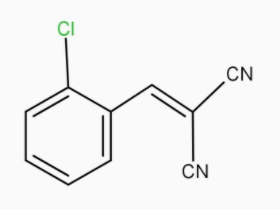
The chemical formula of tear gas is?
A. $CO{ Cl }_{ 2 }$
B. ${ C }_{ 10 }{ H }_{ 5 }{ ClN }_{ 2 }$
C. ${ Cl }_{ 2 }$
D. $PhCOC{ H }_{ 2 }Cl$
Answer
493.5k+ views
Hint: It is formally known as lachrymator agent and it’s a dangerous chemical weapon that causes severe eye and respiratory pain and skin irritation. Now try to figure out by yourself.
Complete step by step answer:
Let us first see what a tear gas is:
So basically, cyano carbon is the defining component of tear gas which is generally referred to as CS gas is an aerosol of a volatile solvent and 2-chlorobenzalmalononitrile, which is a solid compound at room temperature. CS gas is generally accepted as being non-lethal.
I know the above paragraph was a bit complicated!
Let me give you a better idea in simple words.
So tear gas is a common name for lachrymator. Lachrymator is a Latin word which refers to the meaning “tear”. So these agents cause the tear gland to secrete tears, as well they start irritating the mucous membranes and eyes.
It is called a chemical weapon because lachrymator agents were commonly used for riot control during World War 1, and increasingly toxic lachrymators were used.

The compound 2-chlorobenzalmalononitrile also called chlorobenzylidene malononitrile, with chemical formula; $ { C }_{ 10 }{ H }_{ 5 }{ ClN }_{ 2 }$
Common Lachrymators include pepper spray (OC gas), PAVA spray, CS gas, CR gas, CN gas (phenacyl chloride).
Therefore, The chemical formula of tear gas is ${ C }_{ 10 }{ H }_{ 5 }{ ClN }_{ 2 }$.
Hence, option B is the required answer.
Note: You should know that this gas can cause considerable damage to occupants, even kill the very young and elderly. Warning! Under no circumstances one should mess with this gas!
Complete step by step answer:
Let us first see what a tear gas is:
So basically, cyano carbon is the defining component of tear gas which is generally referred to as CS gas is an aerosol of a volatile solvent and 2-chlorobenzalmalononitrile, which is a solid compound at room temperature. CS gas is generally accepted as being non-lethal.
I know the above paragraph was a bit complicated!
Let me give you a better idea in simple words.
So tear gas is a common name for lachrymator. Lachrymator is a Latin word which refers to the meaning “tear”. So these agents cause the tear gland to secrete tears, as well they start irritating the mucous membranes and eyes.
It is called a chemical weapon because lachrymator agents were commonly used for riot control during World War 1, and increasingly toxic lachrymators were used.

The compound 2-chlorobenzalmalononitrile also called chlorobenzylidene malononitrile, with chemical formula; $ { C }_{ 10 }{ H }_{ 5 }{ ClN }_{ 2 }$
Common Lachrymators include pepper spray (OC gas), PAVA spray, CS gas, CR gas, CN gas (phenacyl chloride).
Therefore, The chemical formula of tear gas is ${ C }_{ 10 }{ H }_{ 5 }{ ClN }_{ 2 }$.
Hence, option B is the required answer.
Note: You should know that this gas can cause considerable damage to occupants, even kill the very young and elderly. Warning! Under no circumstances one should mess with this gas!
Recently Updated Pages
How do you factor x2 + x 20 0 class 9 maths CBSE

How do you solve y6x and 2x+3y20 using substitutio class 9 maths CBSE

Chipko movement originated in Gopeshwar in A 1953 B class 9 biology CBSE

The adjacent sides in the parallelogram are supplementary class 9 maths CBSE

The compound used in plastic industry is A Vinyl acetate class 9 chemistry CBSE

How do you solve for y in 2left y dfrac12 right 4left class 9 maths CBSE

Trending doubts
Types of lever in which effort is in between fulcrum class 12 physics CBSE

Distinguish between esterification and saponification class 12 chemistry CBSE

Which are the Top 10 Largest Countries of the World?

A two input XOR Gate produces a high output only when class 12 physics CBSE

Give five points to show the significance of varia class 12 biology CBSE

Which is the correct genotypic ratio of mendel dihybrid class 12 biology CBSE




